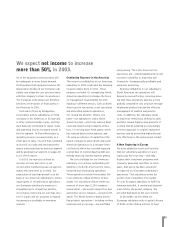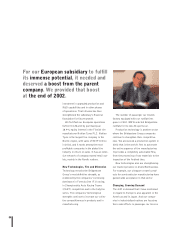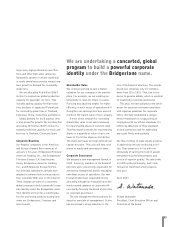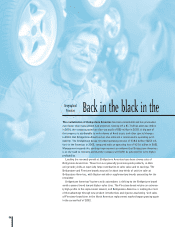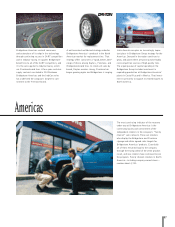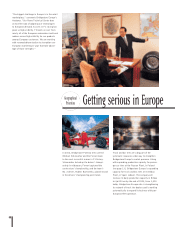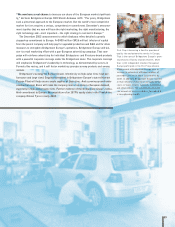Bridgestone 2002 Annual Report Download - page 15
Download and view the complete annual report
Please find page 15 of the 2002 Bridgestone annual report below. You can navigate through the pages in the report by either clicking on the pages listed below, or by using the keyword search tool below to find specific information within the annual report.
13
Localization has long been the guiding principle in Bridgestone manufacturing. The
Bridgestone Group companies have grown by manufacturing large-volume products in
principal markets and by supplementing local production with exports from Japan, such
as ultrahigh-performance tires and off-the-road tires. Now, the group is moving to opti-
mize production globally. The group companies will obtain tires increasingly from the
sources best suited to their circumstances. That will mean a growing volume of third-
country exchange among Bridgestone Group companies.
Bias tires, for example, are a shrinking market segment in industrialized nations, but
they remain a mainstay of newly emerging markets. That is because of their superior
durability on rough roads and their price-competitiveness. The Bridgestone Group will
maximize cost-competitiveness in bias tires by concentrating the production of those tires
principally in Thailand and Indonesia. Similarly, plants in Costa Rica and Mexico will
supply a growing volume of commodity-grade radial tires to the North American market.
Other globalization under way in the Bridgestone Group includes plant construction
projects in Thailand and China. Work has begun on new Thai plants for truck and bus
tires and for carbon black, a crucial raw material in tires. Bridgestone will build its first
new plant in China for passenger car tires. That plant will join two Chinese plants that
the group has acquired for producing passenger car tires and truck and bus tires.
Quality remains the overriding emphasis in the Bridgestone Group’s globalization.
Attesting to the group’s continuing success in attaining premium-grade quality was a
worldwide Supplier of the Year Award from General Motors for 2002. That was the
Bridgestone Group’s eighth consecutive Supplier of the Year Award from GM.
Bridgestone Europe’s Poznan Plant produces
high-performance and large-sized tires for pas-
senger cars in the European market. Opened
in 2000, the Poznan Plant is the youngest tire
plant in the Bridgestone Group’s global produc-
tion network. It also is a strategic platform
for sharpening Bridgestone Europe’s focus on
high-value tires. The company will increase the
plant’s daily production capacity for large and
high-performance tires to 23,000 tires by 2006
year-end, from 10,000 at present. In parallel
with the expansion work in Poland, Bridgestone
is expanding production capacity for high-value
tires at six plants in Japan. Accompanying that
expansion is a shift of production capacity for
some commodity-grade tires to Thailand and
Indonesia.
look at globalization
Bridgestone’s new BIRD production system,
unveiled in 2002, will support unprecedented
flexibility in responding to evolving global
demand. BIRD stands for Bridgestone
Innovative and Rational Development. The
system automates the entire sequence of
processes in tire manufacturing, from the
initial processing of materials to the final
inspection of the finished tires. BIRD can pro-
duce multiple sizes of tires simultaneously,
which allows for making tires efficiently in
small lots. Its compact, integrated configuration
will make the system easy to deploy globally.
In addition, BIRD’s advanced information
processing will allow for remote monitoring
and management of production in real time.


